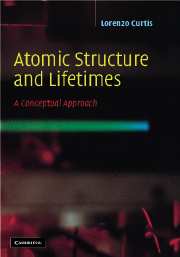Book contents
- Frontmatter
- Contents
- Preface
- List of physical constants and useful interrelations
- 1 Introduction
- 2 Semiclassical conceptual models
- 3 Semiempirical parametrization of energy-level data
- 4 The vector model of angular momentum
- 5 The intermediate coupling model
- 6 Electric dipole radiation
- 7 Line strengths in two-valence-electron systems
- 8 Magnetic dipole transitions
- 9 Absorption of radiation
- 10 Time-resolved measurements
- 11 Hyperfine structure
- 12 Electrostatic polarizabilities and long-range interactions
- 13 Coherence and anisotropic excitation
- References
- Index
8 - Magnetic dipole transitions
Published online by Cambridge University Press: 06 July 2010
- Frontmatter
- Contents
- Preface
- List of physical constants and useful interrelations
- 1 Introduction
- 2 Semiclassical conceptual models
- 3 Semiempirical parametrization of energy-level data
- 4 The vector model of angular momentum
- 5 The intermediate coupling model
- 6 Electric dipole radiation
- 7 Line strengths in two-valence-electron systems
- 8 Magnetic dipole transitions
- 9 Absorption of radiation
- 10 Time-resolved measurements
- 11 Hyperfine structure
- 12 Electrostatic polarizabilities and long-range interactions
- 13 Coherence and anisotropic excitation
- References
- Index
Summary
All things decay. Strive diligently.
– Last words of BuddhaA first-rate theory predicts; a second-rate theory forbids; a third-rate theory explains after the event.
– Alexsander Isaakovich KitaigorodskiiMuch of the language of atomic physics was inspired by early studies of hydrogen and other atoms of low Z to moderate Z, where the dynamics are dominated by the electrostatic Coulomb interaction. Thus the n-dependent Balmer energy splittings, which are proportional to Z2, are called the “gross energy,” and the J -dependent Sommerfeld energy splittings, which are proportional to Z4, are called the “fine structure.” E1 processes, which are the primary radiative coupling between gross structure levels, are called “allowed” transitions, and M1 processes, which are the primary radiative coupling among fine structure levels, are called “forbidden” transitions. Clearly this Z-scaling causes the situation to enter a new domain for highly ionized heavy atoms, where “fine structure” can exceed “gross structure” and “forbidden” transition rates can exceed “allowed” transition rates. Isoelectronic studies can provide a fine-tuning mechanism, whereby the interactions can be studied at values of Z where they are strong to elucidate their contributions at values of Z where they are weak.
M1 transitions
In the zeroth-order nonrelativistic limit there is only electrostatics, and thus no magnetic dipole moment. In the first-order relativistic correction to the electrostatic problem, the magnetic dipole moment is given by μ = μB(L + geS), and contains only angular factors. Since the Schrödinger picture separates radial and angular portions completely, the orthogonality of the radial wave functions restricts M1 processes in this approximation to occur only in transitions between levels within the same configuration.
- Type
- Chapter
- Information
- Atomic Structure and LifetimesA Conceptual Approach, pp. 164 - 178Publisher: Cambridge University PressPrint publication year: 2003



